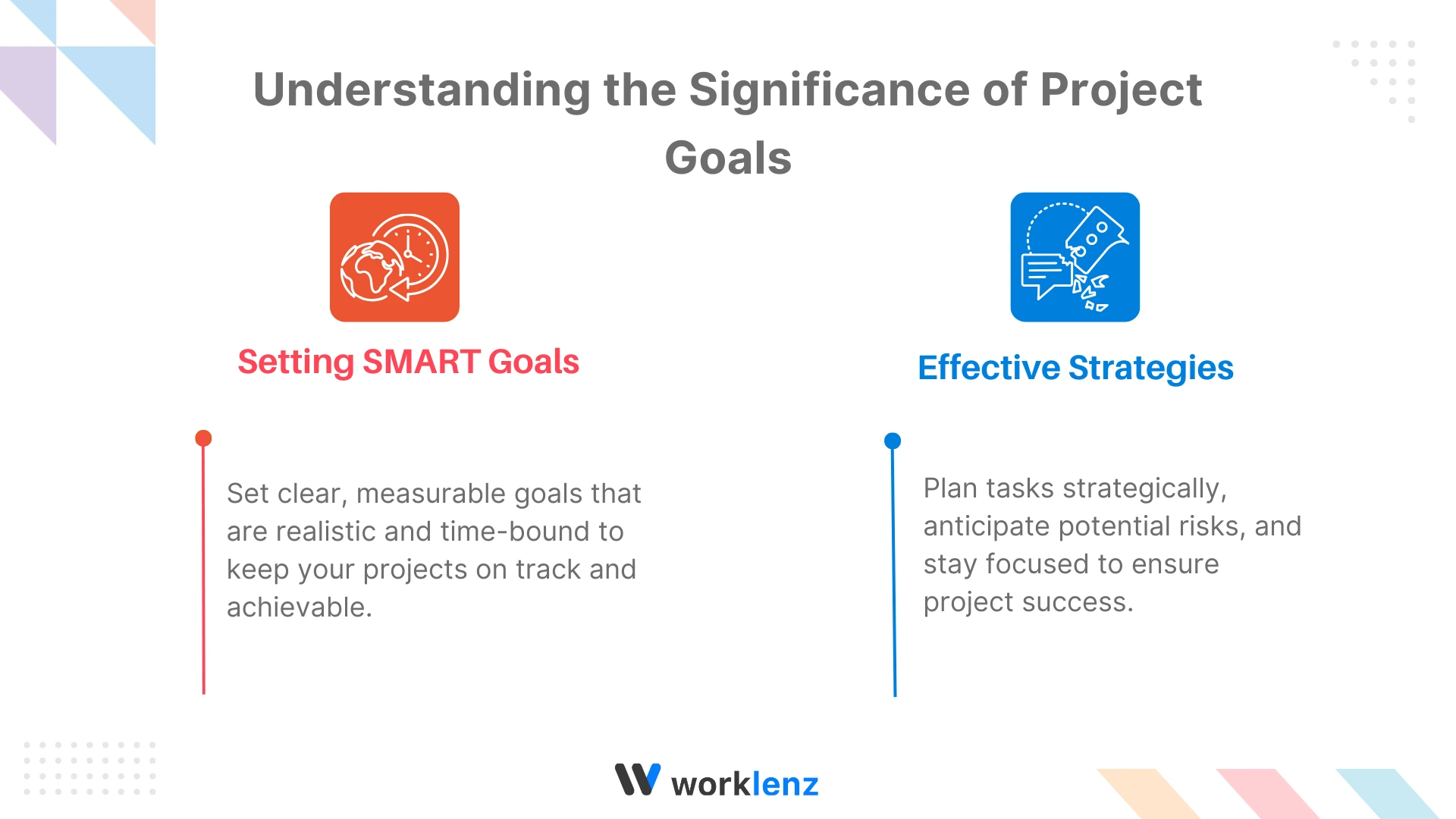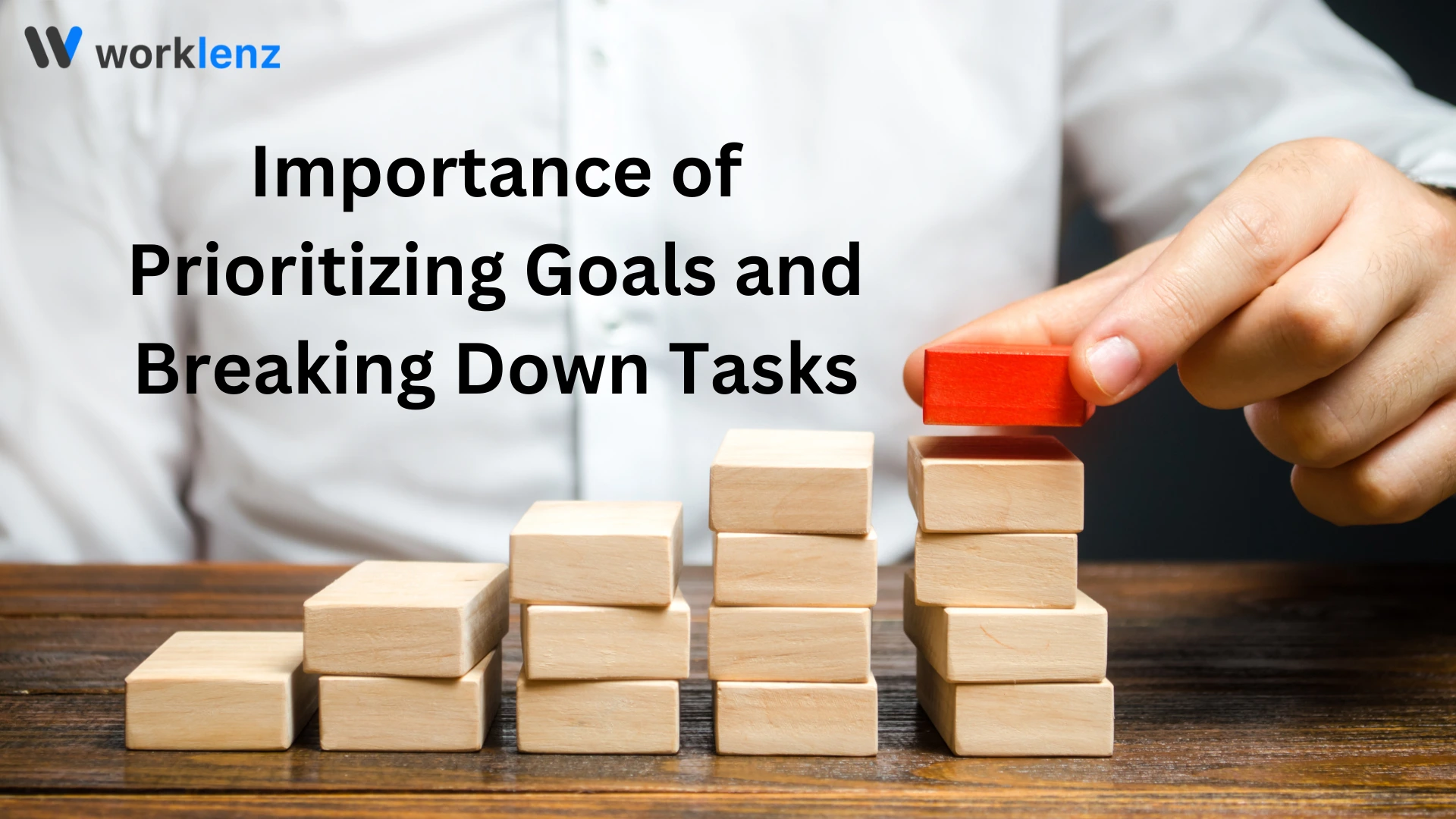
Did you know that 70% of projects fails to achieve their goal? So setting realistic project goals is a crucial step for successful project management. You can significantly increase the chances of achieving project objectives
In this article, we will explore effective strategies and techniques for creating achievable project goals that drive success.
It is better to first understand why they are so important in achieving success of your projects than getting into the specifics of setting project goals blindly. You can lay the foundation for a successful project right from the start by setting smart Goals and using effective strategies.

Before diving in he nitty-gritty of project goals, it’s essential to grasp why they matter for project success. By doing so, you can lay a solid foundation right from the start.
Remember, a well-defined goal and a strategic approach significantly enhance your project’s chances of success!
Setting realistic goals like charting a course fo your project. It helps you navigate through challenges and stay focused on what truly matters.
Crafting a Path to Project Success, When you establish realistic goals and adhere to effective strategies during project planning, you create a clear roadmap. This roadmap provides a detailed plan that guides you at every step, rather than embarking on an uncertain journey. Not only does this approach enhance your project’s chances of success, but it also boosts confidence and motivation among team members.
Now, let’s delve deeper into the process of defining clear objectives. It’s tim to clarify what you truly want to achieve with yut project!
”Defining clear objectives” is the first step you need to take when it comes to setting realistic project goals. Apart from that you can make sure that your goals are specific, measurable, attainable, relevent, and time-bound by clearly dscussing what you want to achieve.
To help you in creating achievable project objectives here are some project goal-setting tips:
Setting clear objectives is like building a strong foundation for your project, It provides direction, focus, and clarity, making it easier to stay on track and achieve your desired outcomes - Jane Smith, Project Manager
Example: Setting SMART Objectives
Let’s take the example of a software development project:
Objective - Develop a User-Friendly Mobile App
SMART Criteria
Specific: Create a mobile app for iOS and Android platforms with a simple and intuitive user interface.
Measurable: Achieve a minimum rating of 4 stars on app stores and receive positive user feedback.
Attainable: Ensure that the required technical skills and resources are available within the project team or can be acquired.
Relevant: Align the app’s features and functionality with the target audience’s needs and preferences.
Time-Bound: Complete the development and launch of the app within six months.
You are taking yourself up for success by defining clear objectives using SMART criteria. These tips will help you in creating achievable project objectives and increase the likelihood of project success.
After establishing SMART goals, it’s essential to follow a structured project management process. You can learn more about how to break down goals and deliverables effectively in our article on The Five-Step Project Management Process.
The research phase plays an essential role in preparing for effective project planning strategies.
There are some key areas to focus on during the research process:
-Analyze Market Trends
By staying up to date with market trends you can understand the current state and recognize potential opportunities and challenges
-Understanding the Customer Needs
You can gain a better understanding of their needs by conducting market research and getting feedback from potential customers.
-Assessing Risks and Constraints
Identifying any potential risks or constraints that that could impact the feasibility of your project including resource limitations, regulatory requirements, or technological limitations and you can set realistic goals that are achievable within the given constraints by understanding and addressing these challenges early on.
Successful project goal-setting involves collaboration with key stakeholders. Engaging stakeholders early on ensures their buy-in and helps align project goals with organizational objectives. By involving stakeholders in the goal-setting process, you can create shared ownership and increase the likelihood of success.
Collaborating with stakeholders is a crucial aspect of effective project planning strategies. When you bring together individuals who have a vested interest in the project’s success, you tap into a wealth of knowledge, experience, and perspectives that can greatly enhance your project outcomes.
By engaging stakeholders early in the goal-setting process, you allow them to contribute their insights and expertise. This not only helps you set more realistic and achievable goals but also ensures that the project aligns with the overarching objectives of the organization.
Stakeholder collaboration is the secret sauce of successful project planning. By involving key stakeholders, you harness their diverse perspectives and prevent potential roadblocks down the line.
When stakeholders are actively involved in goal setting, they develop a sense of shared ownership and responsibility for the project’s success. This sense of ownership drives their commitment and investment in the project, increasing the chances of achieving the desired outcomes.
Furthermore, collaborating with stakeholders helps identify potential risks, challenges, and dependencies early on. By involving them in the planning process, you gain valuable insights that can inform your decision-making and mitigate potential obstacles that may arise during project execution.
nto manageable tasks. Project management goal-setting techniques can help you streamline your efforts and improve the overall efficiency of your project. By prioritizing your goals, you can focus on the most important aspects of your project and allocate your resources effectively.
Breaking down your goals into smaller tasks is equally important. By doing so, you make them more accessible and easier to tackle. This approach allows you to gain greater clarity and maintain a sense of progress as you complete each task. Whether you’re working on a complex project or a simple one, breaking down tasks ensures that you stay focused and organized throughout the entire process.
Here are some project management goal-setting techniques to prioritize your goals and break down tasks effectively:
Identify your top priorities Start by identifying the most important goals that align with the overall project objectives. These are the goals that will have the greatest impact on the success of your project.
Categorize goals based on urgency and importance Use a matrix or a similar tool to categorize your goals based on their urgency and importance. This will help you determine which goals need to be addressed immediately and which can be tackled later.
Define milestones Break down your goals into smaller milestones or checkpoints. These milestones act as progress markers and help you track your project’s advancement. They also provide a sense of accomplishment and motivation as you achieve each milestone.
Delegate tasks Assign tasks to team members based on their skills, expertise, and availability. Delegating tasks ensures that the workload is distributed evenly and that each task is assigned to the most qualified individual.
Set deadlines Set deadlines: Establish deadlines for each task and milestone to ensure timely completion. Setting realistic deadlines helps you manage expectations and avoid unnecessary delays.
By employing these project management goal-setting techniques, you can prioritize your goals effectively and break them down into manageable tasks. This approach not only enhances your project planning process but also improves your chances of achieving success in your projects.
Once you have defined clear objectives, it’s crucial to prioritize your goals and break them down into manageable tasks. Project management goal-setting techniques can help you streamline your efforts and improve the overall efficiency of your project. By prioritizing your goals, you can focus on the most important aspects of your project and allocate your resources effectively.
Breaking down your goals into smaller tasks is equally important. By doing so, you make them more accessible and easier to tackle. This approach allows you to gain greater clarity and maintain a sense of progress as you complete each task. Whether you’re working on a complex project or a simple one, breaking down tasks ensures that you stay focused and organized throughout the entire process.

Here are some project management goal-setting techniques to prioritize your goals and break down tasks effectively:
Identify your top priorities: Start by identifying the most important goals that align with the overall project objectives. These are the goals that will have the greatest impact on the success of your project.
Categorize goals based on urgency and importance: Use a matrix or a similar tool to categorize your goals based on their urgency and importance. This will help you determine which goals need to be addressed immediately and which can be tackled later.
Define milestones: Break down your goals into smaller milestones or checkpoints. These milestones act as progress markers and help you track your project’s advancement. They also provide a sense of accomplishment and motivation as you achieve each milestone.
Delegate tasks: Assign tasks to team members based on their skills, expertise, and availability. Delegating tasks ensures that the workload is distributed evenly and that each task is assigned to the most qualified individual.
Set deadlines: Establish deadlines for each task and milestone to ensure timely completion. Setting realistic deadlines helps you manage expectations and avoid unnecessary delays.
By employing these project management goal-setting techniques, you can prioritize your goals effectively and break them down into manageable tasks. This approach not only enhances your project planning process but also improves your chances of achieving success in your projects.
Setting realistic deadlines is essential for effective project planning strategies. When establishing deadlines for your project, it is important to consider various factors to ensure that they are achievable and realistic.
Firstly, take into account the complexity of the tasks involved in your project. Determine the time required for each task and evaluate whether the overall timeline aligns with the scope and resources available. This evaluation will help you avoid overestimating what can be accomplished within a given time frame.
Secondly, consider the availability of resources. Assess the availability of team members, equipment, and other necessary resources for completing the project. Ensure that the allocation of resources aligns with the timeline and that there are no conflicts or overlaps.
Thirdly, identify any dependencies or constraints that may affect the project timeline. Determine if there are any tasks or activities that are dependent on others or have external dependencies. This step will help you identify any potential bottlenecks and adjust the timeline accordingly to prevent unnecessary delays.
By setting achievable deadlines, you can promote a more efficient workflow, reduce stress levels, and increase the likelihood of successfully meeting project goals. Clear and realistic deadlines provide a sense of direction and motivate team members to stay focused and productive.
Once you have set realistic project goals, it is essential to continuously monitor the progress and make necessary adjustments along the way. By regularly tracking the progress of your project against the set goals, you can ensure that you are on the right track to achieving success. Here are some effective project planning strategies to consider:
Regularly monitor the progress of your project by tracking key metrics and milestones. This allows you to assess whether you are making progress toward your goals or if any deviations require attention. Use project management tools or software to keep a record of project progress and identify areas for improvement.
Compare the actual progress of your project against the planned targets. This will help you identify any gaps or variations between what was initially estimated and the current status. By analyzing this data, you can gain insights into potential bottlenecks or areas where adjustments need to be made.
Hold regular team meetings to discuss the progress of the project and identify any challenges or roadblocks. This provides an opportunity for team members to provide updates, share insights, and collaborate on solutions. By staying in constant communication, you can quickly address any issues and ensure everyone is aligned with the project goals.
Be open to adapting your plans based on the progress and feedback received. As you monitor the project, you may discover new insights or obstacles that require adjustments to your original strategy. By being flexible and willing to make changes, you can navigate unexpected challenges and maximize the chances of project success.
Monitoring progress and making necessary adjustments are crucial to effective project planning. By regularly tracking progress, comparing actual vs. planned targets, conducting team meetings, and being adaptable, you can ensure that your project stays on track and increases its chances of achieving the desired outcomes.
Setting realistic project goals is the key to driving success without stress. With the right strategy and tools, your team can stay on track, meet deadlines, and deliver outstanding results.
Worklenz makes goal setting and project execution effortless with its self-hosted task management solution. Ready to take control of your projects?
➡ Sign up for free and start managing your tasks efficiently.
📅 Book a demo to see Worklenz in action!